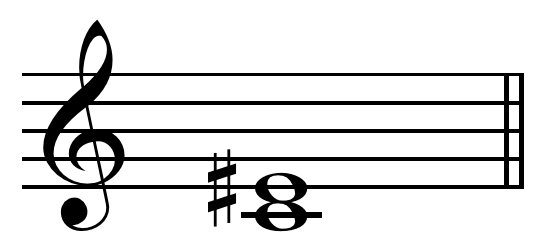Augmented Third on:
[Wikipedia]
[Google]
[Amazon]
 In
In
 In
In classical music
Classical music generally refers to the art music of the Western world, considered to be distinct from Western folk music or popular music traditions. It is sometimes distinguished as Western classical music, as the term "classical music" also ...
from Western culture
Leonardo da Vinci's ''Vitruvian Man''. Based on the correlations of ideal Body proportions">human proportions with geometry described by the ancient Roman architect Vitruvius in Book III of his treatise ''De architectura''.
image:Plato Pio-Cle ...
, an augmented third () is an interval of five semitones
A semitone, also called a half step or a half tone, is the smallest musical interval commonly used in Western tonal music, and it is considered the most dissonant when sounded harmonically.
It is defined as the interval between two adjacent no ...
. It may be produced by widening a major third
In classical music, a third is a musical interval encompassing three staff positions (see Interval number for more details), and the major third () is a third spanning four semitones. Forte, Allen (1979). ''Tonal Harmony in Concept and P ...
by a chromatic semitone
In modern Western tonal music theory an augmented unison or augmented prime is the interval between two notes on the same staff position, or denoted by the same note letter, whose alterations cause them, in ordinary equal temperament, to be one ...
.Benward & Saker (2003). ''Music: In Theory and Practice, Vol. I'', p.54. . For instance, the interval from C to E is a major third, four semitones wide, and both the intervals from C to E, and from C to E are augmented thirds, spanning five semitones. Being augmented, it is considered a dissonant
In music, consonance and dissonance are categorizations of simultaneous or successive Sound, sounds. Within the Western tradition, some listeners associate consonance with sweetness, pleasantness, and acceptability, and dissonance with harshness ...
interval.Benward & Saker (2003), p.92.
Its inversion
Inversion or inversions may refer to:
Arts
* , a French gay magazine (1924/1925)
* ''Inversion'' (artwork), a 2005 temporary sculpture in Houston, Texas
* Inversion (music), a term with various meanings in music theory and musical set theory
* ...
is the diminished sixth
In classical music from Western culture, a diminished sixth () is an interval produced by narrowing a minor sixth by a chromatic semitone.Benward & Saker (2003). ''Music: In Theory and Practice, Vol. I'', p.54. . Specific example of an d6 not ...
, and its enharmonic equivalent is the perfect fourth
A fourth is a musical interval encompassing four staff positions in the music notation of Western culture, and a perfect fourth () is the fourth spanning five semitones (half steps, or half tones). For example, the ascending interval from C to ...
.
The just augmented third, E, is 456.99 cents or 125:96. The Pythagorean augmented third, E, is 521.51 cents or 177147:131072, eleven just perfect fifths.
References